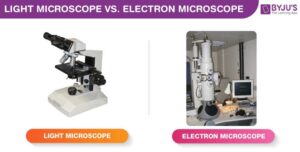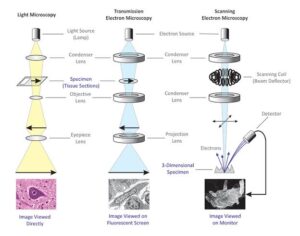Back to: MICROBIOLOGY 100 LEVEL
Welcome to class!
Hello my superstar learner! I’m so excited to have you in class today. You’re growing smarter with every lesson, and that’s something to be proud of. Now imagine trying to see something that is way too tiny for your eyes—like the bacteria in spoilt food or the virus that causes the flu. That’s where microscopes come in! Today, we’ll talk about two main types: light microscopes and electron microscopes—how they work, and what makes them different
Light Vs. Electron Microscopes
Light Microscopes
Light microscopes are the ones most people are familiar with. If you’ve ever used a microscope in your school biology lab, it was most likely a light microscope.

They use visible light and glass lenses to magnify small objects. Light passes through the specimen (usually a thin slice of it), and lenses bend the light to make the image bigger. These microscopes can magnify objects up to around 1,000 to 1,500 times their original size.
Light microscopes are perfect for seeing things like:
Cells (like onion or cheek cells)
Small bacteria
Algae and fungi
They are cheaper, easier to use, and portable, which is why they are common in schools and hospitals across Nigeria.
Electron Microscopes
Now, electron microscopes are like the superstars of microscopes! Instead of light, they use a beam of electrons to view specimens. Electrons are much smaller than light particles, which means these microscopes can show us things in much greater detail.
They can magnify objects up to 2 million times! That means they can show us things as tiny as the internal structures of a virus or the surface of a bacteria.
There are two main types:
Transmission Electron Microscope (TEM): Shows the inside of a specimen.

Scanning Electron Microscope (SEM): Shows the surface in 3D.
However, electron microscopes are very expensive, very large, and need a special lab to operate. You won’t find one in a regular school or clinic.
Summary
- Light microscopes use visible light and are great for general lab use.
- Electron microscopes use electron beams and show much finer details.
- Light microscopes are cheaper and easier to use.
- Electron microscopes are powerful but expensive and used in advanced labs.
Evaluation
- What do light microscopes use to magnify objects?
- Name one thing an electron microscope can see that a light microscope cannot.
- List two differences between light and electron microscopes.
- Which type of microscope would you most likely find in a school lab?
Keep shining and believing in yourself—you’re learning skills and knowledge that can change the world. Remember, Afrilearn is here with you every step of the way. Can’t wait to see you in the next exciting lesson!
